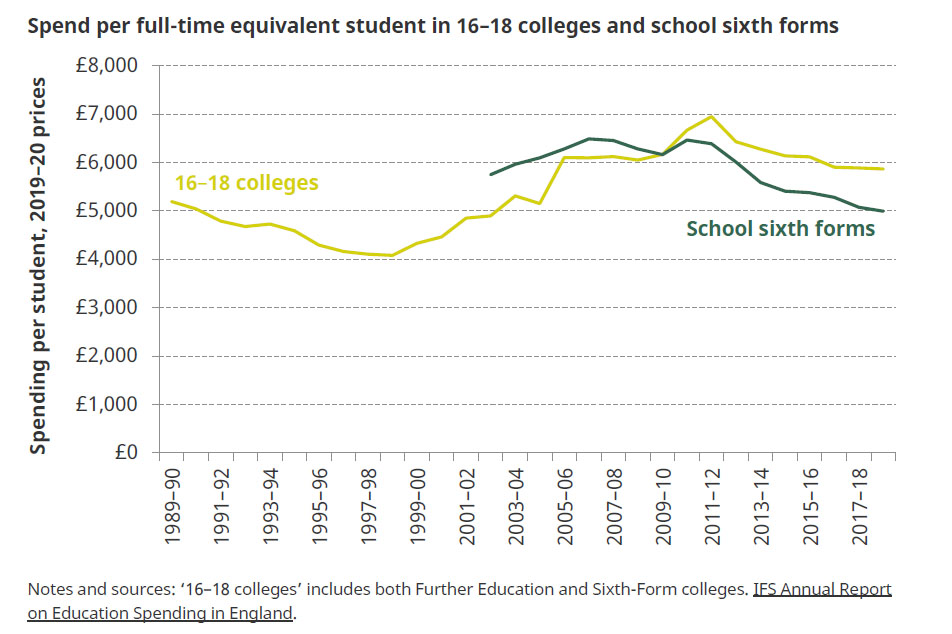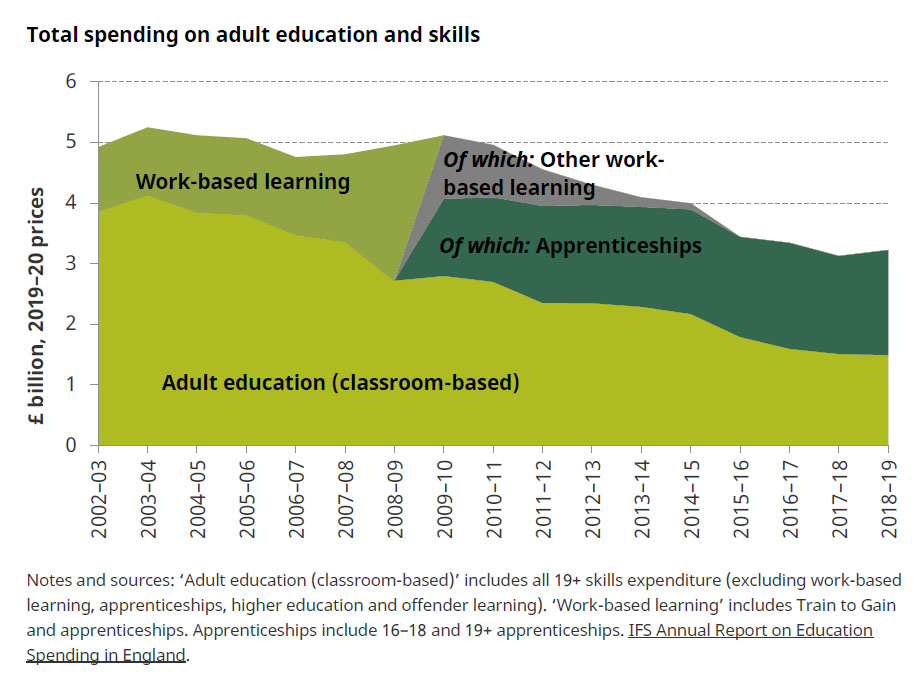Post 16 education spending
At age 16, young people face a range of education options. About 43% of young people continue in a school sixth form, where they mostly study A-level or other academic qualifications. Another 40% opt to study full-time in sixth form or further education colleges. Young people in further education colleges are more likely to study vocational programmes and tend to be from more disadvantaged backgrounds.
About 5% of young people opt to take an apprenticeship, a number which has been largely constant over the past decade despite increasing government focus on apprenticeships. The remaining 12% of young people are in some other form of training, employment or none of the above.
Colleges and sixth forms have faced large cuts in recent years. Between 2010–11 and 2018–19, spending per student aged 16 to 18 in further education and sixth form colleges fell by 12% in real terms, and by 23% in school sixth forms. Following on from larger cuts during the 1990s and lower growth than most other stages of education during the 2000s, college spending per student is due to be only about 13% greater in 2018–19 than it was almost 30 years earlier in 1989–90.
In the September 2019 Spending Round, the government has allocated an extra £300 million for further education colleges and sixth forms for 2020–21 (in today’s prices). This will lead to a real-terms increase in spending per pupil of over 4% in 2020–21, but will still leave spending per student over 7% or £450 below its level in 2010–11 in colleges and over 20% or £1,450 below in school sixth forms.
The government plans to introduce new vocational qualifications called T levels. These new qualifications seek to simplify the choices available to young people into 15 different lines of learning, raise the prestige of vocational qualifications and increase classroom learning time.
These are laudable aims. However, they are coming on a very tight timetable: T levels are due to be rolled out from 2020 onwards. Furthermore, ‘raising the prestige’ of vocational qualifications has been the goal of numerous governments over at least the last 30 years. In practice this has meant turbulence in the sector, with successive major reforms quickly superseded by another. For T levels – or any other reform to FE – to have a chance to succeed, they’ll require both sufficient funding and sufficient time to bed in.
Adult education and apprenticeships
Total spending on adult education (excluding apprenticeships) has fallen by nearly two-thirds since 2003–04. This combines cuts of 32% up to 2009–10 and of a further 47% between 2009–10 and 2018–19. These cuts have mainly been driven by falls in learner numbers, which have fallen from 4.4 million in 2004–05 to 1.5 million in 2017–18. This fall in learner numbers was mainly a deliberate attempt to reduce the number of adults taking relatively small and low-level qualifications. The recent Augar review of post-18 education has recommended reversing a range of the cuts to adult education.
Spending specifically targeted at apprenticeships rose by 36% in real terms between 2009–10 and 2018–19. This was partly driven by more apprenticeships amongst adults aged 19 or over. Despite this, the government still seems likely to miss its target for 3 million new apprenticeship starts between 2015 and 2020 by a wide margin. However, an increasing share of individuals on apprenticeships are now on A-level-equivalent courses or higher (over 60% to date in 2018–19 as compared with around 40% in 2011–12), which are generally more valuable in the labour market than lower-level apprenticeships.







